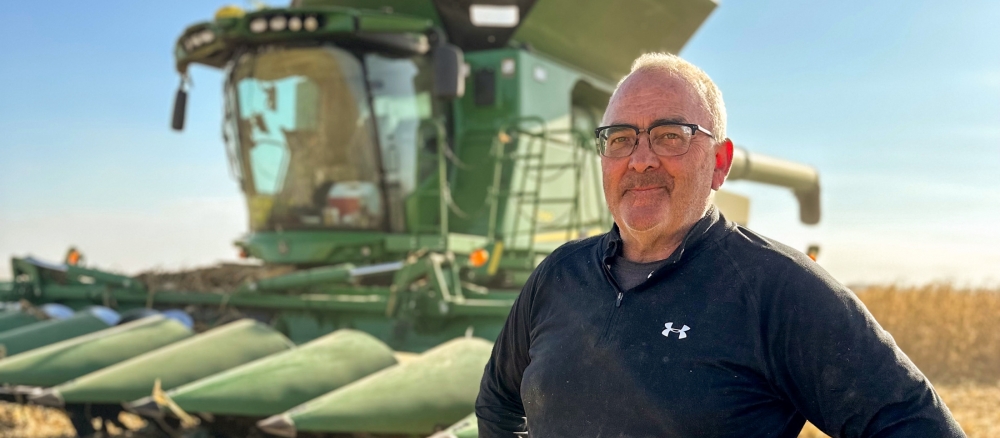How cover crops and manure injection keep a Minnesota farm going for future generations
Randy Spronk knows a thing or two about farming. The third-generation farmer has spent decades working the land atop the high-elevation Buffalo Ridge in southwest Minnesota, and in that time, he’s testified in front of the World Trade Organization in Geneva, he served as president of the National Pork Producers Council, and he’s even been called a “master of the pork industry.”
He knows a thing or two about farming, but he also knows that he could stand to learn a thing or two too, particularly about the effective use of cover crops and about working the land sustainably.
“I think this is really the way we’re headed,” he says. “We’re making a very deliberate decision to make the farm viable for the next generation.”
Cover crops that pull double duty
Spronk speaks a mile a minute from the cab of his somewhat slower tractor. His experiences in the fields and raising pigs stretch back more than 40 years, when he took over the farm from his father. He says he doesn’t want to keep farming well into his pending retirement years, but he’s nevertheless eager to see how the hybrid rye he’s planting in a recently harvested soybean field will do as a cover crop for the coming winter.
“I’m a newbie when it comes to cover crops,” he admits. “I wouldn’t say I’m a late adopter, but I can at least access people who have experience with them.”
When he started out farming, he says, common practice was to plow after the harvest, turning over the soil and exposing the black dirt to the elements all winter. That only led to erosion from the wind and the rain and the snowmelt, so he eventually switched to a disc chisel that left crop residue in the fields then a vertical tillage tool that pins that residue to the top two to three inches of the soil.
Only in the last three years, however, has he tried planting cover crops for the winter. He tried turnips in one field so his neighbors could graze cattle on them, but to complement his own operations — raising hundreds of thousands of pigs as well as growing soybeans and corn on nearly 3,000 acres — he’s largely focused on two types of rye: cereal and hybrid.
“Basically, you want something living in the soil year round,” he says. “The cover crops hold the soil in place, and they also uptake the nutrients in the soil and hold those in place until the spring, when they die off and release those nutrients back in the soil.”
The cereal rye, he’s discovered, has an allelopathic effect on other plants, particularly weeds, so he can go all winter without applying herbicide to the fields.
The hybrid rye has the benefit of deep roots that effectively till the soil as well as greater seed yields, which Spronk can then run through his on-farm feed mill to supplement the corn that he feeds to the pigs.
Each has its challenges, and Spronk says he’s still working out exactly how to transition from cover crops to regular crops in the spring as well as how to manage the cover crops at his elevation, but he’s kept his approach to them simple so far so he can continue to educate himself on the topic.
“I’m pretty sure you have to make these mistakes so you can learn from them,” he said.
A high-tech on-farm circular economy
Spronk can speak so enthusiastically from the cab of his tractor because the machine automates so much of a farmer’s job with pinpoint precision thanks to advanced data gathering and analysis.
“I kept a notebook for so many years, so when John Deere came out here, I told them I don’t want to keep a notebook any longer,” he says.
Instead, his tractor’s cab is more like a modern office with a steering wheel. Screens allow him to keep tabs on his farm’s various operations, including the rate at which the tractor distributes the hybrid rye seed in his fields. Similarly, when it comes time to fertilize those fields, he can also specify the exact amount of manure to apply.
“The number one way to prevent runoff is to use what’s called a VTI toolbar, which injects the manure into the ground then has covering or sealing discs to close the trench,” Spronk says. “After you make the pass, you don’t see any liquid on top; the soil absorbs it immediately.”
Benefits of a sustainable farm
This focus on sustainability does help the farm’s bottom line, Spronk admits, but that’s not the only reason he’s implemented practices like these. His customers appreciate the increased transparency, and he is measurably sequestering carbon from the atmosphere.
“If it’s $20 an acre cheaper, that means $20 a bushel more in profits,” he says. “But I also take pride in what I do. I can produce a protein — a tasty protein — in a sustainable manner that’s not degrading the soil.”
According to Lisa Scheirer, a supervisor with the Minnesota Pollution Control Agency’s feedlots section, Spronk’s practices have a positive impact on the environment.
“These actions help prevent and avoid problems through proactive planning, protecting surface and ground waters from contamination,” she said.
Spronk appreciates the environmental benefits of the changes he’s made on his farm; he likes knowing that he’s not putting the nearby endangered Blanding’s turtle in any additional peril, for instance. But he’s just as concerned with making sure the farm stays put for his son to take over in the coming years.
“I want the following generation to be able to use it, and the succeeding three generations after that,” he says.

